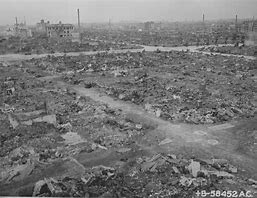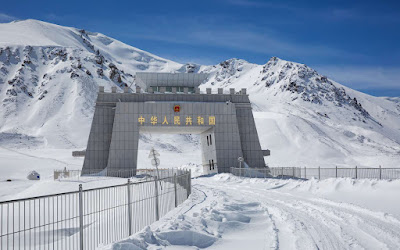Japan’s evolution after the nuclear war has been nothing short of extraordinary. The country was left devastated after the bombing of Hiroshima and Nagasaki, but the resilience of its people and the dedication of its government helped it rise from the ashes. Today, Japan is one of the world’s most advanced and prosperous nations. In this article, we’ll take a closer look at Japan’s evolution after the nuclear war and how it rebuilt itself. The nuclear bombings of Hiroshima and Nagasaki in 1945 were the deadliest in history, causing catastrophic damage and loss of life. Japan was left in ruins, and the world was left stunned. However, Japan did not give up, and its people showed immense resilience and dedication to rebuilding their nation from scratch. Today, Japan is thriving with a strong economy, advanced technology, and a unique culture.
World War II was a devastating global conflict that resulted in staggering casualties and loss of life. Japan was one of the many nations impacted by the war, with both military and civilian casualties. It is believed that Japan suffered around 3 million military deaths and over one million civilian deaths during the conflict. These losses were a result of various factors, including battles on Japanese soil, bombing raids, and the effects of the atomic bombs dropped on Hiroshima and Nagasaki.
The overall number of casualties during World War II is difficult to estimate, but it is widely accepted that the war resulted in an unprecedented level of destruction and loss of life. It is estimated that between 70-85 million people died as a result of the conflict, including military and civilian casualties. The vast majority of these losses occurred in Europe and Asia, with the Soviet Union and China suffering the highest number of casualties.
The human toll of World War II is difficult to comprehend, and the scale of the conflict’s devastation is a sobering reminder of the cost of war. The impact of the war on the world was far-reaching and long-lasting, with economic, political, and social repercussions felt for decades after the conflict ended. The memory of the war and its impact on global affairs remains a powerful force in shaping international relations and foreign policy to this day.
Brief History
The causes of World War II are complex and multifaceted, but it is generally understood that the tussle between Japan and America was one of the contributing factors. In the 1930s, Japan was seeking to expand its territory and exert its influence in Asia, while the United States was committed to a policy of containment and deterrence. Japan’s aggressive behaviour in the region, including its invasion of China, led to tensions with the United States and other Western powers. The United States responded by imposing economic sanctions on Japan and cutting off its access to vital resources like oil. Japan saw these actions as a threat to its national security and responded with a surprise attack on the United States at Pearl Harbor in 1941, which drew the United States into the war.
Causes of the Atomic Bombing
The decision to drop the atomic bombs on Hiroshima and Nagasaki was made by the United States as a way to bring an end to the war with Japan. The bombings were part of a larger strategy to force Japan’s surrender, which had been reluctant to do so despite the losses it had sustained in the war. One of the reasons for the decision to drop the atomic bombs was to avoid the need for an invasion of the Japanese mainland, which was expected to result in massive casualties for both the Japanese and the Allies. The United States hoped that the bombings would force Japan to surrender and avoid the need for a land invasion. Another reason was the desire to showcase the power of the atomic bomb to the Soviet Union, which was seen as a potential threat to US interests in the post-war world. By demonstrating the destructive power of the bomb, the United States hoped to discourage the Soviet Union from expanding its influence. Despite the justifications given for the bombings, they remain a controversial and heavily debated topic. Many have questioned the morality of using such a devastating weapon, especially against civilian populations. Others have argued that the bombings were necessary to bring a quicker end to the war and save lives in the long run.
The Political Climate of the Time
The political climate in Japan at the time of the nuclear bombings was heavily influenced by the country’s military government, which had led Japan into World War II. The government had a strong grip on the country’s policies, and dissent was not tolerated. The bombings had a profound impact on the government and the Japanese people, leading to the eventual collapse of the military government.
After the war, Japan was occupied by the United States and its allies, and a new government was established. The new government, led by Prime Minister Shigeru Yoshida, implemented a series of reforms aimed at rebuilding the country and creating a stable democracy. The reforms included the creation of a new constitution, the establishment of a parliamentary system, and the promotion of free speech and civil liberties.
The new government also focused on building strong diplomatic ties with other nations, particularly the United States. This partnership with the United States helped to fuel Japan’s economic growth, with the US providing aid and technical expertise to help rebuild the country’s infrastructure and industries.
Today, Japan is known for its stable democracy and peaceful approach to international relations. The country has a parliamentary system of government, with a prime minister as the head of government and an emperor as the symbolic head of state. Japan is also a member of the United Nations and a founding member of the G7.
The Strategic Implications of the Bombing
The strategic implications of the atomic bombings of Hiroshima and Nagasaki were significant, both for Japan and for the world. For Japan, the bombings marked the end of World War II and the beginning of a new era of peace and stability. For the world, the bombings demonstrated the destructive power of nuclear weapons and the need for international cooperation to prevent their use.
The atomic bombings of Hiroshima and Nagasaki were part of a larger military strategy aimed at ending the war in the Pacific. The United States, which was engaged in a bitter conflict with Japan, believed that the bombings would force Japan to surrender, thus bringing an end to the war. While the bombings did result in Japan’s surrender, they also raised serious questions about the morality of using nuclear weapons in warfare.
The bombings also had significant strategic implications for the future of international relations. The use of nuclear weapons in warfare had never been seen before, and the world was now faced with the possibility of an all-out nuclear war. This led to the development of the doctrine of mutually assured destruction (MAD), which held that any use of nuclear weapons would result in the total destruction of both sides. This doctrine helped to prevent nuclear war during the Cold War, but it also raised the spectre of a global nuclear apocalypse.
In the wake of the bombings, there were also calls for the international community to come together to prevent the use of nuclear weapons in the future. This led to the establishment of the United Nations and the creation of the Nuclear Non-Proliferation Treaty (NPT), which aimed to prevent the spread of nuclear weapons and promote disarmament. While the NPT has been successful in preventing the spread of nuclear weapons to some extent, the continued possession of nuclear weapons by a few countries remains a major threat to global security.
In conclusion, the strategic implications of the atomic bombings of Hiroshima and Nagasaki were significant and far-reaching. While the bombings marked the end of World War II and brought about a new era of peace and stability in Japan, they also raised serious questions about the morality of using nuclear weapons in warfare and the need for international cooperation to prevent their use in the future. The bombings also contributed to the development of the doctrine of mutually assured destruction and led to the establishment of the UN and the NPT, both of which continue to play a vital role in global security.
The Question of Morality
The bombings of Hiroshima and Nagasaki remain controversial to this day, with some questioning the morality of using such devastating weapons. Some argue that the bombings were necessary to end the war quickly and save lives, while others argue that the bombings were unnecessary and constituted war crimes.
Those who defend the bombings argued that they were necessary to end the war quickly and prevent a much larger loss of life. The alternative to the bombings would have been a full-scale invasion of Japan, which would have resulted in a much higher death toll on both sides. They also argue that the bombings were necessary to demonstrate the destructive power of nuclear weapons and discourage their future use.
On the other hand, those who oppose the bombings argue that they were unnecessary and constituted war crimes. They argue that Japan was already on the brink of surrender and that the bombings were unnecessary to end the war. They also argue that the bombings were indiscriminate and caused immense suffering to civilians, who were not involved in the war.
The question of morality is a complex and divisive issue that continues to be debated to this day. It is important to remember the devastating consequences of the bombings and to continue to work towards a world free of nuclear weapons.
The Aftermath of the Bombing
The aftermath of the bombing was catastrophic, with a death toll estimated at over 200,000. The cities of Hiroshima and Nagasaki were reduced to rubble, and the survivors of the bombing were left to grapple with the physical, emotional, and psychological scars of the attack. In the immediate aftermath of the bombing, there was chaos and confusion as people struggled to find their loved ones and come to terms with the magnitude of the destruction.
The survivors of the bombing suffered from severe injuries, radiation sickness, and psychological trauma. The effects of radiation exposure were particularly insidious, as they often did not manifest until years after the bombing. Many of the survivors developed cancers and other radiation-related illnesses, and their descendants have also experienced higher rates of cancer and birth defects.
The Japanese government was ill-equipped to deal with the aftermath of the bombing, and it took years for the country to develop the necessary infrastructure and programs to support the survivors. In the early years after the bombing, the survivors were often stigmatized and shunned by society, as people feared that they might be contagious or that they might pass on radiation sickness to their children.
Over time, however, the survivors of the bombing began to organize and speak out about their experiences. They formed support groups and advocacy organizations, and they worked to ensure that their stories were not forgotten. Today, the survivors of the bombing are known as hibakusha, and they continue to speak out about the need for nuclear disarmament and the devastating consequences of nuclear war.
The bombing of Hiroshima and Nagasaki also had profound geopolitical implications. It marked the beginning of the nuclear age, and it sparked an arms race between the United States and the Soviet Union. The bombing also raised questions about the morality of using atomic weapons in warfare and set a precedent for the use of nuclear weapons in future conflicts.
Despite the devastating consequences of the bombing, Japan was able to rebuild itself from the ashes. The country’s remarkable resilience and determination helped it to recover from the devastation of the war and become one of the world’s most prosperous and advanced nations. Today, Japan serves as a powerful symbol of the human capacity for resilience and recovery in the face of unimaginable tragedy.
The survivors of the bombings suffered from severe injuries, radiation sickness, and psychological trauma. However, despite the devastating aftermath, the Japanese people did not lose hope.
Japan’s road to Recovery
After the bombings of Hiroshima and Nagasaki, Japan was left in ruins, and the road to recovery was a long and challenging one. The country had to rebuild its infrastructure, economy, and social structure from scratch. The recovery process was complicated by factors such as the country’s limited resources, the devastation caused by the bombings, and the psychological trauma suffered by the survivors.
Despite these challenges, Japan was able to make significant progress towards recovery in the years following the bombings. The government played a crucial role in Japan’s recovery by investing heavily in the country’s reconstruction. It implemented policies to encourage economic growth and implemented social programs to support the survivors of the bombings. Japan’s people also played a critical role in the recovery by working tirelessly to rebuild their communities.
In conclusion, Japan’s road to recovery after the nuclear bombings was a long and challenging one, taking several years to rebuild its infrastructure, economy, and social structure from scratch. However, through the resilience and dedication of its people and the support of its government, Japan was able to make significant progress towards recovery. The country’s economic boom and technological innovations during its recovery period continue to impact industries worldwide today.
1. The road to recovery
Japan’s road to recovery was a long and arduous one. The country had to rebuild its infrastructure, economy, and social structure from scratch. The government played a crucial role in Japan’s recovery by investing heavily in the country’s reconstruction. It implemented policies to encourage economic growth and implemented social programs to support the survivors of the bombings. Japan’s people also played a critical role in the recovery by working tirelessly to rebuild their communities.
2. The economic boom
One of the most remarkable achievements of Japan’s post-war recovery was its economic boom. In the 1960s and 1970s, Japan experienced a period of rapid economic growth, which is now commonly referred to as the “Japanese Miracle.” The country’s economy grew at an average rate of 10% per year, and its manufacturing industry became one of the most efficient and productive in the world. The economic boom was fueled by a combination of government investment, technological innovation, and a strong work ethic among the Japanese people.
3. Technological innovation
Japan’s post-war recovery was also characterized by remarkable technological innovation. The country’s manufacturing industry developed advanced technologies that were adopted by industries worldwide. Japan became a leader in the development of electronics, robotics, and automobile manufacturing. The invention of the transistor and the development of integrated circuits laid the foundation for the digital revolution that transformed the world in the latter half of the 20th century.
4. Rebuilding infrastructure
Another significant aspect of Japan’s post-war recovery was the rebuilding of its infrastructure. The country’s transportation system was modernized, and new highways and railway lines were constructed. Tokyo’s public transportation system became one of the most efficient in the world. The country also invested heavily in its energy infrastructure, constructing new power plants and modernizing its electrical grid.
5. Social programs
In addition to rebuilding its economy and infrastructure, Japan’s government implemented various social programs to support the survivors of the bombings and their families. The government provided medical care and financial assistance to those suffering from radiation sickness and other related illnesses. It also established support programs for the families of those who lost their lives in the bombings.
6. Preserving culture
Despite the massive devastation caused by the bombings, Japan’s culture survived and even thrived in the post-war years. The country’s traditional arts, such as calligraphy, tea ceremony, and flower arrangement, were preserved and celebrated. Japan’s entertainment industry also experienced a boom, with the emergence of manga, anime, and video games, which have become globally popular.
Support of the Japanese Government
After the bombings of Hiroshima and Nagasaki, the Japanese government faced the daunting task of caring for the survivors and rebuilding the country. The government played a critical role in supporting the survivors of the bombings and helping them rebuild their lives.
One of the first steps taken by the government was to provide medical care to those who were injured in the bombings. Hospitals and clinics were quickly established in the affected areas to provide treatment to the wounded. The government also set up mobile medical units to provide care to those who were unable to travel to hospitals.
In addition to medical care, the government provided financial assistance to the survivors. The survivors were provided with compensation for their losses, including their homes and property, and assistance in finding new places to live. The government also provided food and clothing to those who were in need.
To support the families of those who lost their lives in the bombings, the government established to support programs. These programs included financial assistance, housing assistance, and educational support for the children of those who were killed.
The government also implemented policies to encourage economic growth and create jobs. It invested heavily in infrastructure development and implemented social programs to support the survivors of the bombings. The government’s efforts played a crucial role in Japan’s recovery and helped the country to become one of the world’s most advanced and prosperous nations.
The Most Significant Achievements of Japan’s Post-War Recovery
The country’s economic boom, technological innovation, and rebuilding of infrastructure were some of the most significant achievements of Japan’s post-war recovery. Here are some statistics that support the achievements of Japan’s post-war recovery:
- Japan’s Gross Domestic Product (GDP) grew at an average annual rate of 7.6% from 1955 to 1973, making it one of the fastest-growing economies in the world at the time.
- In 1968, Japan became the second-largest economy in the world, behind only the United States.
- Japan’s manufacturing industry experienced tremendous growth during the post-war period, with companies like Toyota, Sony, and Honda becoming household names.
- The construction of new highways, railways, and airports helped to modernize Japan’s transportation infrastructure, making it easier for people and goods to move around the country.
- Japan’s post-war recovery also included a significant investment in education, resulting in a highly skilled and educated workforce.
These achievements have allowed Japan to become one of the most prosperous and technologically advanced countries in the world. The country’s post-war recovery can serve as a model for other developing regions, highlighting the importance of investing in infrastructure, education, and innovation.
The Role of American Culture
The role of American culture in Japan’s post-war evolution cannot be overstated. After the war, the U.S. occupied Japan and imposed its cultural values and practices on the Japanese people. The occupation led to the introduction of American popular culture, including music, movies, and fashion, to Japanese society. This had a significant impact on the country’s youth, who were drawn to American-style clothing and music.
The introduction of American culture also had a profound impact on Japanese art and literature. Many Japanese artists and writers were inspired by American styles and techniques, leading to the emergence of a new wave of Japanese art and literature.
However, the imposition of American culture was not without its critics. Some Japanese nationalists viewed the introduction of American culture as a threat to Japanese traditions and values. Nevertheless, the influence of American culture on Japan’s post-war evolution cannot be denied. Today, Japan has a unique cultural identity that is influenced by both traditional Japanese culture and American popular culture.
Survival of Japan’s Culture
Despite the massive devastation caused by the bombings, Japan’s traditional arts and entertainment industry were preserved and even experienced a boom in the post-war years. After the bombings, Japan’s culture faced significant challenges, but it managed to survive and thrive in the post-war years. Japan’s traditional arts and entertainment industry, including music, theatre, and dance, managed to survive the destruction caused by the bombings. In fact, these industries experienced a boom in the post-war years, with the popularity of traditional Japanese art forms spreading both domestically and internationally.
One of the significant factors contributing to the resurgence of Japan’s culture was the country’s economic growth and increased wealth. With more disposable income, people had the means to support the traditional arts, which helped to preserve and promote them. Additionally, the government played a significant role in supporting the arts and cultural industries by providing funding and incentives.
Today, Japan’s cultural exports are widely celebrated and enjoyed around the world. Japanese anime, manga, video games, and fashion have become global phenomena, with millions of fans worldwide. The traditional arts and crafts industry also remains a vital part of Japan’s economy, with tourists flocking to the country to experience its rich cultural heritage.
In conclusion, Japan’s culture managed to survive and thrive after the bombings, despite the challenges it faced. Through government support, economic growth, and the preservation of traditional art forms, Japan was able to rebuild and emerge as a cultural powerhouse on the global stage. This serves as a valuable lesson for developing regions, highlighting the importance of preserving and promoting cultural heritage as a means of economic and social development.
US-Japan Post-War Relations
Following the atomic bombings of Hiroshima and Nagasaki, relations between the United States and Japan were initially fraught with tension and mistrust. The bombings were seen as a heinous act by many in Japan, and the death and destruction caused by the bombings left a deep scar on the country’s psyche.
However, in the post-war period, the United States took steps to rebuild its relationship with Japan, including providing significant aid to support Japan’s recovery efforts. The Marshall Plan, which was launched by the United States in 1948 to help rebuild war-torn Europe and Japan, provided $2.2 billion in aid to Japan, which helped to rebuild the country’s infrastructure and economy.
In addition, the United States played a key role in helping Japan establish a new constitution and democratic government. The Constitution of Japan, which was adopted in 1947, was heavily influenced by the United States and included provisions for free elections, the protection of basic human rights, and the renunciation of war as a means of settling international disputes.
Today, the relationship between the United States and Japan is one of the most important bilateral relationships in the world. According to the U.S. Department of State, the two countries have a strong and mutually beneficial relationship that is based on shared values and interests. In 2019, the United States and Japan signed a new trade agreement that eliminated tariffs on a wide range of goods and services, further strengthening their economic ties. The two countries also cooperate closely on a range of security issues, including the threat posed by North Korea’s nuclear program and the broader issue of regional stability in Asia.
In conclusion, while the atomic bombings of Hiroshima and Nagasaki created initial strains between the United States and Japan, the two countries have since worked to rebuild their relationship and have developed a strong and mutually beneficial partnership.
China-Japan Post-War Relations
Following World War II, the relationship between China and Japan has been complex and at times tumultuous. Japan’s actions during the war, including its brutal occupation of China, led to significant resentment and animosity from the Chinese people.
However, in the post-war period, both countries worked to improve their relationship. Japan provided significant economic aid to China in the 1970s, helping to jumpstart China’s economic growth. In recent years, however, tensions have risen again, with disputes over territory and historical grievances causing friction in the relationship.
In 2022, the relationship between China and Japan remains strained, with several issues complicating the two countries’ diplomatic ties. Japan has raised concerns about China’s military expansion and its territorial claims in the East and South China Seas, while China has expressed frustration with Japan’s continued emphasis on the historical grievances between the two countries.
Despite these tensions, both countries have significant economic ties, with China being Japan’s largest trading partner and Japan being China’s second-largest trading partner. Both countries have also made efforts to increase cultural exchanges and people-to-people ties, with various initiatives aimed at promoting tourism and cultural understanding.
Overall, while the relationship between China and Japan remains complex and at times fraught, both countries have important economic ties and are working to find common ground on a range of issues.
The Development of Japan in the IT Era
Japan has long been known as a technological powerhouse, and its rise as a leader in the information technology (IT) industry is no exception. From the 1980s to the present day, Japan has made significant strides in the development of cutting-edge technologies and digital innovations, driving its economy forward and improving the overall quality of life for its citizens.
One of the key factors contributing to Japan’s success in the IT industry is its strong commitment to research and development. The country invests heavily in scientific research and technology, with government initiatives aimed at fostering innovation and collaboration between private and public sectors. As a result, Japan has developed a reputation for producing high-quality, innovative products and services, from advanced robotics and artificial intelligence to sophisticated medical equipment and semiconductors.
Japan’s economic growth in the IT sector has been impressive, with the country’s IT market estimated to be worth over $140 billion. It is also home to some of the largest and most influential technology companies in the world, including Sony, Panasonic, and Toshiba, to name just a few. These companies have played a significant role in shaping the global IT industry, with products and services that have transformed the way we live and work.
Beyond its economic success, Japan’s IT industry has also had a profound impact on Japanese society as a whole. Digital technology has revolutionized the way that people in Japan interact with one another and consume information. Social media platforms and messaging apps have become ubiquitous in Japanese culture, with people using these tools to connect with friends and family, build new communities, and stay informed about the world around them.
In addition, the rise of e-commerce has transformed the way that Japanese consumers shop and make purchases, with online marketplaces and delivery services making it easier and more convenient than ever before to access a wide range of goods and services.
As Japan continues to move forward in the era of information technology, it is poised to maintain its position as a leader in the industry. By leveraging its strengths in research and development, innovation, and collaboration, Japan will continue to drive the development of cutting-edge technologies that improve people’s lives, boost economic growth, and advance the country’s overall progress.
In conclusion, Japan’s success in the IT industry has been a major factor in its economic and overall progress over the past several decades. Through its commitment to research and development and its focus on innovation and collaboration, Japan has become a leader in the development of cutting-edge technologies and digital innovations, transforming the way that people live, work, and interact with one another. As developing regions look to learn from Japan’s experience, they can take inspiration from Japan’s focus on research and development, as well as its commitment to fostering collaboration between private and public sectors, to help drive their own progress in the IT industry and beyond.
Japan’s Economy Today
Japan, one of the world’s leading economies, has faced various economic challenges in recent years, but the country has shown resilience and has taken steps to address these issues. As of 2022, the economic situation in Japan is stable, although there are some areas of concern.
One of the main concerns for Japan’s economy in recent years has been deflation, a situation in which prices fall over time. The Japanese government has implemented various measures to address this issue, including monetary policies designed to stimulate inflation. These policies have been successful to some extent, with the inflation rate in Japan increasing from 0.2% in 2020 to 0.8% in 2021.
Another area of concern for Japan’s economy is the country’s ageing population. Japan has one of the world’s lowest birth rates, and the proportion of elderly people in the population is increasing. This has led to a shrinking workforce and increased pressure on the country’s social security system. To address this issue, the Japanese government has implemented various policies designed to encourage immigration and support families with young children.
Despite these challenges, Japan’s economy is still one of the largest and most developed in the world. The country has a highly skilled and educated workforce, a strong manufacturing sector, and a diverse economy. In 2021, Japan’s GDP was approximately $5 trillion, making it the world’s third-largest economy after the United States and China.
The country’s manufacturing sector is a key driver of the economy, with companies such as Toyota, Honda, and Sony leading the way in innovation and production. Japan is also a major exporter of automobiles, electronics, and other high-tech products, which account for a significant portion of the country’s GDP.
In addition to its manufacturing sector, Japan is a leader in the fields of robotics, biotechnology, and renewable energy. The country has made significant investments in these areas, and companies such as Softbank and Panasonic are at the forefront of these industries.
One area of growth in Japan’s economy in recent years has been the tourism industry. In 2019, the country welcomed a record 31.9 million visitors, generating an estimated $44 billion in revenue. However, the COVID-19 pandemic has had a significant impact on the industry, with tourist numbers falling sharply in 2020 and 2021.
Overall, Japan’s economy has shown resilience and adaptability in the face of various challenges. The country has a strong foundation in manufacturing and innovation and has made significant investments in emerging industries such as robotics and renewable energy. While there are areas of concern, such as the ageing population and deflation, the Japanese government has implemented policies designed to address these issues and ensure continued economic growth and stability.
Conclusion
Japan’s evolution after the nuclear war was a remarkable feat of resilience and determination. The country overcame the devastation caused by the bombings to become one of the world’s most advanced and prosperous nations. The government’s dedication to investing in the country’s reconstruction, the hard work of the Japanese people, and the remarkable technological innovations made during the post-war years all contributed to Japan’s recovery. Today, Japan’s unique culture, advanced technology, and strong economy continue to make it a leader in the world.
What can Pakistan learn from Japan’s evolution?
Japan’s evolution after the atomic bombings of Hiroshima and Nagasaki was a remarkable feat, with the country undergoing a period of rapid and comprehensive development. Japan’s commitment to rebuilding its infrastructure, economy, and social structure from scratch, along with the aid and support it received from the international community, played a crucial role in its success. Lessons from Japan’s experience can be applied to other developing regions, including the importance of investing in education, technology, and infrastructure, as well as the value of resilience and perseverance in the face of adversity. By learning from Japan’s example, developing regions can create a path to sustainable development and growth. Pakistan can learn several lessons from Japan’s evolution after the nuclear war. Here are some of them:
- Resilience: Japan’s people showed immense resilience in the face of adversity. They did not give up, despite the devastation caused by the bombings. Pakistan can learn from this resilience and develop a similar mindset to face its challenges.
- Investment in education: Japan’s investment in education was one of the key factors that led to its success. Pakistan can learn from Japan and invest in education to develop a highly skilled workforce that can contribute to the country’s economic growth.
- Focus on innovation: Japan’s focus on innovation and technological advancement helped it become one of the most advanced nations in the world. Pakistan can learn from this and invest in research and development to develop innovative solutions to its problems.
- Strong governance: Japan’s strong governance played a critical role in the country’s recovery. Pakistan can learn from Japan and develop a strong and efficient government that can implement effective policies and programs to drive economic growth and social development.
- Long-term planning: Japan’s long-term planning and vision for the future helped it become one of the most successful nations in the world. Pakistan can learn from Japan and develop a long-term vision for the country’s development, with a focus on sustainable growth and social progress.






